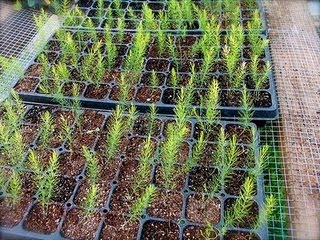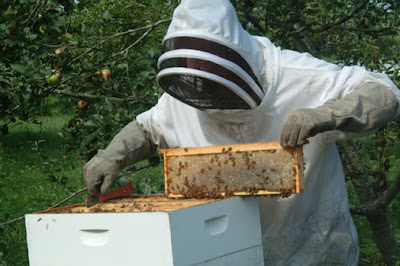Saturday 23 April 2011
GROWING GARLIC IN CONTAINERS
Click here for the 'Seeds of Eaden' seed shop
I often use garlic in my recipes as it is such a distinctive tasting herb that brightens up many dishes. It is very simple to grow at home even if you do not have much space in your garden. You can plant either directly into the soil or into pots if you wish to save space.
There are many different varieties of garlic that you could select, but ensure you select a cultivated variety which is suitable for colder climates. This is because you should plant garlic in pots in mid-October as the cold weather helps to produce garlic with larger bulbs and more cloves. Do not plant supermarket bought garlic as they would have been treated with a chemical to prevent sprouting and will not tolerate cold conditions. If you wish to plant as late as April you can, but the garlic will be smaller. However you could use supermarket cloves at this time of year as it is warmer, just ensure you wash the cloves thoroughly before use.
Select a suitable container and fill it with John Innes 'Seed and potting' compost. Separate the bulb into single cloves and select the bigger, stronger cloves. The individual cloves should be planted 15 cm apart, or place a single clove in each pot. Plant in an upright position, tip pointing upwards, in a hole 3 cm below the soil. Water thoroughly and place the container in a sunny position. Feed the containers in the summer with general purpose plant food every two weeks.
The garlic is ready for harvesting around August/September depending on variety type. You need to lift them when they are ripe, as lifting too early will mean the bulbs are too small, and lifting them too late will diminish their taste. They are likely to be ready when the leaves start to turn brown. You can check if they are ready to harvest by removing a bulb and peeling off the papery layers surrounding the bulb; if you can remove three layers than it is ready to harvest, but if you can remove more than they are not ready so leave them for a few weeks. When lifting garlic, gently remove the bulb with a trowel to prevent bruising. To store garlic bulbs successfully, wash and dry the bulbs and place in warm area to dry out. Once dried they can be stored for 3-4 months.
For related articles click onto:
Feeding plants
Growing Garlic in Containers
Herbaceous borders
How to grow garlic
How to grow lavender
How to build a cold frame
How to grow coriander
How to grow garlic
How to Grow Ginger
How to grow parsley
How to grow seeds indoors
Preparing a seed bed
What is a potager?
Wednesday 20 April 2011
HOW TO GROW ASPARAGUS FROM SEED
Click here for the 'Seeds of Eaden' seed shop
Asparagus can be grown from seed outside directly into the soil as soon as the ground is warm enough, usually end of April. Seeds can be given a head start by sowing indoors in late February. Before sowing, soak the seeds in water for a couple of hours in order to break the dormancy period and speed up germination. Sow seeds into individual pots with John Innes 'seed' compost. Water gently and place pots in a warm room which is approximately 15-18 degrees Celsius. When germination has taken place, move the pots to a windowsill but do not place in full sun. Before planting outside the seedlings will have to be hardened off. Move the plants outside during the day over a period of 3 weeks after the threat of frost has passed.
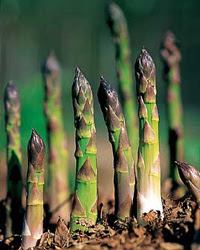 Asparagus is a crop vegetable and is not grown on a rotation system. Prepare the bed by incorporating n plenty of humus and possibly some grit or sharp sand to open them up. Asparagus are best planted in raised, deep beds. Plant 30-45 cm apart in rows, at a depth of 5cm below the level of the compost. Water throughout the summer and ensure weeds are removed as these will compete for nutrients within the soil.
Asparagus is a crop vegetable and is not grown on a rotation system. Prepare the bed by incorporating n plenty of humus and possibly some grit or sharp sand to open them up. Asparagus are best planted in raised, deep beds. Plant 30-45 cm apart in rows, at a depth of 5cm below the level of the compost. Water throughout the summer and ensure weeds are removed as these will compete for nutrients within the soil.
Do not take a crop in the first year. Foliage forms from the spears, and this should be cut in the autumn to 5-10cm high when it starts to yellow. Cover the asparagus with 10cm soil in spring, incorporating a fertiliser. In year two remove a maximum of 8 spears per plant. This can be doubled in year three.
For related articles click onto:
Feeding plants
How to grow broccoli from seed
How to grow cauliflower from seed
How to build a cold frame
How to Grow Agave from Seed
How to grow beetroot from seed
How to grow cabbage from seed
How to grow carrots from seed
How to grow cucumbers from seed
How to grow french beans from seed
How to grow leeks from seed
How to grow lettuce from seed
How to grow onions from seed
How to grow peas
How to grow runner beans from seed
How to grow seeds indoors
How to grow strawberries from seed
How to grow tomatoes
How to grow tomatoes from seed

Do not take a crop in the first year. Foliage forms from the spears, and this should be cut in the autumn to 5-10cm high when it starts to yellow. Cover the asparagus with 10cm soil in spring, incorporating a fertiliser. In year two remove a maximum of 8 spears per plant. This can be doubled in year three.
For related articles click onto:
Feeding plants
How to grow broccoli from seed
How to grow cauliflower from seed
How to build a cold frame
How to Grow Agave from Seed
How to grow beetroot from seed
How to grow cabbage from seed
How to grow carrots from seed
How to grow cucumbers from seed
How to grow french beans from seed
How to grow leeks from seed
How to grow lettuce from seed
How to grow onions from seed
How to grow peas
How to grow runner beans from seed
How to grow seeds indoors
How to grow strawberries from seed
How to grow tomatoes
How to grow tomatoes from seed
Monday 18 April 2011
RECIPE FOR PLUM CHUTNEY
Click here for the 'Seeds of Eaden' seed shop
I was inspired by this recipe after a friend gave me a jar of this plum chutney as it was so delicious. The jar didn’t last long, and the second jar was eaten even faster. At this point, to preserve the friendship and not embarrass myself by asking for another jar, I decided to get the recipe instead. It is very delicious and one jar will not be enough, you have been warned…….
Ingredients
2lb plums
12 oz raisins
1 lb brown sugar
1 lb carrots
1 pint vinegar
1 garlic clove
1 tea spoon chili powder
1 knuckle finely chopped fresh ginger or 1 teas spoon ground ginger
2 teaspoons salt
Prepare jam jars by sterilising in hot water. This recipe will make 3 lb of plum chutney.
Stone and pit the plums, and cut into quarters. Grate the carrots. Place the prepared plums and carrots into a saucepan and add the vinegar. Simmer for 10 minutes until tender.
Crush the garlic and add to the pan along with all the other ingredients. Simmer for 20 minutes, stirring occasionally, until mixture is thick.
Spoon the chutney into the jar jars. Place a jam jar disc on the top and replace lid whilst jar is still hot as this will help to seal the jar. Label the jar.
For related articles click on the links below:
Banana loaf recipes
Lemon meringue pie
Loaf cakes
Recipe for Asparagus Quiche
Recipe for blackcurrant cheesecake
Recipe for cauliflower cheese
Recipe for cherry pie
Recipe for English Apple pie
Recipe for Italian tomato sauce
Recipe for pea salad with mint
Recipe for pickled cucumber
Recipe for Plum Chutney
Recipe for rhubarb crumble
Recipe for Salmon with lemon and herbs
Recipe Spaghetti bolognese
Recipe for spinach and broccoli fritatta
Recipe for strawberry cheesecake
Recipe for strawberry jam
Recipe for tomato soup
Friday 15 April 2011
CAN YOU KEEP BEES IN YOUR GARDEN?
It is entirely possible to keep bees in your garden without disturbing your enjoyment or that of your neighbours. There are no laws against keeping bees in your garden and you do not need a large garden to keep them in. Bees are fascinating creatures to watch, and the skill behind setting up a hive and introducing a colony is intriguing. Once you have your bee colony set up you will be hooked.
The wildlife around the hive can be very interesting, and bee keeping can help to look after the garden and countryside. The benefits of having bees within your garden is that they are great pollinators, in addition to producing honey and beeswax. On average 20-40 lb of honey can be obtained from the hive in a season. Beeswax can be used for producing candles, soap, furniture polish and cosmetics. And of course honey can be fermented into mead.
Bees kept by bee keepers are the honey bee species, Apis mellifera. These honeybees turn plant nectar into honey. They also collect pollen, which they use to feed their larvae, and natural resins (propolis) to waterproof and strengthen the hive. Each colony will sustain 50,00 - 70-,000 bees. The hive will work together as a single unit, with the bees having defined roles within the colony. Most bees in the colony are female worker bees, but there are several hundred male drone bees whose role it is to mate with young queens. There is only one queen bee, who will lay up to 2000 eggs a day. The worker bees tend and feed the larvae, construct and clean the wax comb cells, serve as guards at hive entrance and collect pollen and nectar from plants.
The wildlife around the hive can be very interesting, and bee keeping can help to look after the garden and countryside. The benefits of having bees within your garden is that they are great pollinators, in addition to producing honey and beeswax. On average 20-40 lb of honey can be obtained from the hive in a season. Beeswax can be used for producing candles, soap, furniture polish and cosmetics. And of course honey can be fermented into mead.
Bees kept by bee keepers are the honey bee species, Apis mellifera. These honeybees turn plant nectar into honey. They also collect pollen, which they use to feed their larvae, and natural resins (propolis) to waterproof and strengthen the hive. Each colony will sustain 50,00 - 70-,000 bees. The hive will work together as a single unit, with the bees having defined roles within the colony. Most bees in the colony are female worker bees, but there are several hundred male drone bees whose role it is to mate with young queens. There is only one queen bee, who will lay up to 2000 eggs a day. The worker bees tend and feed the larvae, construct and clean the wax comb cells, serve as guards at hive entrance and collect pollen and nectar from plants.
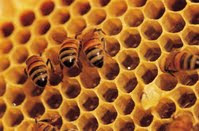 To get started you need to select a bee hive. There are many different styles of bee hive but all have movable frames. Choose a hive that works for you, one that provides ease of access and is suitable for your location. The bees will not mind which hive you select! Hives can be bought new or second hand, or you may make one from scratch. Ensure second hand hives are sterilised thoroughly as diseases can be spread on old combs and equipment.
To get started you need to select a bee hive. There are many different styles of bee hive but all have movable frames. Choose a hive that works for you, one that provides ease of access and is suitable for your location. The bees will not mind which hive you select! Hives can be bought new or second hand, or you may make one from scratch. Ensure second hand hives are sterilised thoroughly as diseases can be spread on old combs and equipment. You will also require bee-proof clothing - a bee suit or veil, boiler suit, gloves. Tuck your trousers in your socks and cover your head when near a hive. Smoke the colony prior to disturbing it in any way. However, you should expect to receive some stings as part of the hazard of bee keeping. In addition, you will require a smoker and a hive tool.
Once set up you need to introduce the bees. You can purchase bees as a complete colony or part colony, or you may wish to obtain bees from a local bee keeper (check they are free from disease first). You should select bees which produce good yield, are docile and free from disease.
Inspect the hive weekly or fortnightly. Monitor for mites and Varroa, which will be in every colony. You will need to spend a hour a week during the summer maintaining the hive, checking the health of the bees and ensuring the hive is clean. You should understand the life cycle of the queen bee and look out for signs of a swarming colony. It is advisable to speak to your local Bee Keepers association or enrol on a college course to study bee keeping in more detail. The British Bee Keepers Association website is ideal to get further information on the subject.
Bee facts
Do worms sleep?
Feeding plants
Herbaceous borders
How do I attract bees into my garden?
Potagers
What is the difference between an insect and a spider?
What is the difference between a wasp and a hornet?
Wednesday 13 April 2011
HOW TO GROW GINGER
Often, I end up with some left over ginger after following a recipe and throw it into a kitchen cupboard, hoping I will find a use for it, only to rediscover it months later when it has sprouted. I like to use fresh ginger in my recipes and surplus ginger can be planted up for future use.
The ginger plant is similar in appearance to a lily, with a thick green stem and wide leaves. The leaves are dark green in colour with a prominent midrib. Ginger plants can reach a height of almost 1 metre, with greenish yellow flowers. It grows from a underground stem, the rhizome. All the energy and reserves are saved in the rhizome, and new plant material arises from it through a process called budding.
It is the ginerols within this aromatic herb that gives this plant its distinctive taste. Ginger is used to treat a number of disorders including improving digestive activity, correcting liver function, relaxing muscles and stimulating circulation.
Propagating ginger
Select a piece of fresh, shop bought ginger. Wash the ginger and remove knuckles and segments that are approx 2 cm. Place the ginger pieces on a windowsill for 2-3 days to seal the cuts.
 To achieve the perfect soil for growing ginger, mix one part horticultural grit with three parts John Innes seed and cutting compost. Place this soil mixture into a tall, narrow pot and plant the ginger on the surface, half buried in the soil. Place on a sunny windowsill or in a greenhouse, or propagator. Bottom heat will ensure they have a head start, but is not required if temperature is kept at around 25 degrees.
To achieve the perfect soil for growing ginger, mix one part horticultural grit with three parts John Innes seed and cutting compost. Place this soil mixture into a tall, narrow pot and plant the ginger on the surface, half buried in the soil. Place on a sunny windowsill or in a greenhouse, or propagator. Bottom heat will ensure they have a head start, but is not required if temperature is kept at around 25 degrees.You can either directly plant the ginger outside or place the pots outside. Select a well lit position that is not in full sun. The ginger will be ready to harvest when the foliage dies down, in the autumn. Each piece of ginger will have produced a new hand.
New ginger. Ready to use in your kitchen again.
For related articles click onto:
Saturday 9 April 2011
HOW TO MAKE COMPOST
Compost can improve your soil and help manage your garden in order for you to grow more successfully your selection of plants and vegetables. Purchasing compost from garden centres can be expensive so making your own compost can be a money saving idea. Nearly half of the contents of an average dustbin can be composted.
Making your own compost can help to make your more self sufficient within your garden. Compost can be used to feed and condition the soil. It can be applied as a mulch, incorporated within planting holes or used as an ingredient in potting mixtures.
Your compost heap
You can either purchase a composter or make your own composter out of old pallets, and cover the heap with cardboard or polythene. The key is to have somewhere that is enclosed and protected from sunlight, as this will help the heap retain moisture. It needs to be of an adequate size, and a cube of approx 1m is ideal for a medium sized garden. Place the compost heap in a partially shaded area.
You can either purchase a composter or make your own composter out of old pallets, and cover the heap with cardboard or polythene. The key is to have somewhere that is enclosed and protected from sunlight, as this will help the heap retain moisture. It needs to be of an adequate size, and a cube of approx 1m is ideal for a medium sized garden. Place the compost heap in a partially shaded area.
What to put on your compost heap
You are aiming to produce a rich, crumbly, sweet smelling compost. Compost is made from recycled garden and kitchen waste and some waste materials such as paper and cardboard. You need to ensure that you are putting the right quantities of materials on to the compost heap at the right time and let the natural processes do the work. It is the aerobic microbes in the compost heap that break down these materials and produce a usable compost.
You are aiming to produce a rich, crumbly, sweet smelling compost. Compost is made from recycled garden and kitchen waste and some waste materials such as paper and cardboard. You need to ensure that you are putting the right quantities of materials on to the compost heap at the right time and let the natural processes do the work. It is the aerobic microbes in the compost heap that break down these materials and produce a usable compost.
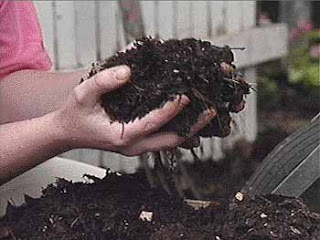 Some materials such as grass mowing and young weeds act as activators, quickly rotting down to get the compost going. These nitrate rich fast rotting materials are known as Greens. Other materials act as the body of the compost, rotting slowly and evenly, and include wood chippings and older plant material. These carbon rich slow rotting materials which make the body of compost are known as Browns. You will need to layer your compost evenly with both Brown and Green materials to ensure that the mixture is ideally suited for composting to occur. You can put the following items in your compost heap:
Some materials such as grass mowing and young weeds act as activators, quickly rotting down to get the compost going. These nitrate rich fast rotting materials are known as Greens. Other materials act as the body of the compost, rotting slowly and evenly, and include wood chippings and older plant material. These carbon rich slow rotting materials which make the body of compost are known as Browns. You will need to layer your compost evenly with both Brown and Green materials to ensure that the mixture is ideally suited for composting to occur. You can put the following items in your compost heap:
Greens
Grass cuttings
Young weeds
Comfrey/nettles
Soft green pruning's
Tea bags
Animal manure
Browns
Woody pruning's/old plants
Hedge clippings
Old plant materials
Leaves
Cardboard & Waste paper (inc. shredded)
Fruit/vegetable peelings (uncooked)
Newspapers/magazines
Pet bedding (hay/straw/paper/wood shavings)
Do not place perennial weeds directly into the compost heap as the seeds will contaminate the mixture. Do not place meat, dairy or cooked foods into your composter, as this will attract vermin.
Compost can be made as quickly as a few months, or as long as a year, depending on what materials you place within it. Layer the heap with alternate layers of green and brown materials at equal quantities. You are aiming to mix items that settle and exclude air, such as grass mowing, with more open items that tend to dry out such as woody pruning's.
Compost should be kept moist to keep it aerobic so ensure that the heap is protected from sunlight at all times and water as required. You should aim to water the heap at every 30 cm layer. Turn your heap every 6 weeks if in regular use. This will help to add air into the heap and mix the contents of the composter. The new air will provide oxygen to the microbes that decompose the material. Mix the materials', adding water if dry, and return it to composter to mature. At this time, you may wish to separate the lower layers of well composted material to use sooner within your garden.
For related articles click onto:
Drainage
Feeding plants
Grass maintenance - laying turf
Grass maintenance - sowing a lawn from seed
Green manure: Broad beans
How to build a cold frame
How to grow seeds indoors
How to make compost
How to take a stem cutting
How to propagate from root cuttings
How to propagate from seed
Lawn care
Lawn grasses
Laying concrete
Manuring
Potagers
Soil structure
Vegetable crop rotation
Tuesday 5 April 2011
GROWING TOMATO PLANTS FROM SEED
You can grow tomato plants outside successfully from seed, either collected by yourself from tomatoes or using shop bought packet tomato seeds.
To give the best yield of tomato crop during the season, you can give your plants a head start by sowing seedlings indoors or in a heated greenhouse around mid march. They will need to be protected from frost, and temperatures at night should not fall below 10 degrees Celsius.
Sow your tomato seeds in seed trays using John Innes 'seedling' compost. Space your seeds evenly across the tray and then cover then with the compost to a depth of 2 cm and lightly water. Place in a well lit place and keep the seeds moist until they germinate, usually between 3 and 5 days.
Seedlings are at risk from fungal rots due to the damp conditions, so good ventilation is important. The seedlings will require high levels of light, around 12-16 hours of sunlight a day. A south facing window sill or shelf in glass house is ideal, although they will require the seed tray to be turned round daily to prevent the seedlings from permanently leaning.
 When the seedlings have produced four leaves they are ready to be pricked out into individual pots. These pots can be filled with a standard potting compost or John Innes potting compost no.1 or 2. Leave some space in the top of the pot in order to earth up the tomato plant as it grows. This breaks the dormancy of the root nodules in the base of the seedling, allowing a stronger root network to establish.
When the seedlings have produced four leaves they are ready to be pricked out into individual pots. These pots can be filled with a standard potting compost or John Innes potting compost no.1 or 2. Leave some space in the top of the pot in order to earth up the tomato plant as it grows. This breaks the dormancy of the root nodules in the base of the seedling, allowing a stronger root network to establish. Prick the seedling out of the seed tray using a pencil/dibber, holding onto the largest leaf, and lift out the root ball carefully. Plant the seedling in the pot at a depth so that most of the stem is covered, with just the leaves showing above the soil line. Water gently.
The seedlings are ready to plant out when the threat of frost is over, usually during May. Prepare a rich, free draining soil, incorporating organic compost or well-rotted farm yard manure. Plant the seedlings in a deep hole, so that the soil line is up to the first set of leaves. This will encourage a stronger root network to establish underground, resulting in healthier plants.
For related articles click onto:
Growing herbs
Growing rhubarb
Growing potatoes
Growing tomatoes
Growing tomatoes from seed
Harvesting potatoes
How to grow cauliflower from seed
How to grow garlic
How to build a cold frame
How to grow artichokes from seed
How to Grow Asparagus from Seed
How to grow cabbage from seed
How to grow carrots from seed
How to grow cucumbers from seed
How to grow french beans from seed
How to grow lettuce from seed
How to grow onions from onion sets
How to grow onions from seed
How to Grow Pumpkins from Seed
How to grow runner beans from seed
How to grow runner beans from seed
How to grow seeds indoors
How to grow strawberries from seed
How to grow tomatoes from seed
How to make compost
How to propagate using division
How to propagate from seed
Sunday 3 April 2011
LINKS
Click below to view the links:
A Homesteading Neophyte
Natura i Medi Ambient
Sweet as Sugar Cookies
The Bird Garden Blog
The Patient Gardener
The Natural Gardener
Vegpatchblog
Saturday 2 April 2011
HOW TO GROW GIANT ONIONS FROM SEED
Click here for the 'Seeds of Eaden' seed shop
I am very excited that I have recently been bought a packet of giant onion seeds. I love giant vegetables and cant wait to impress (?) my family and friends with my onion in the autumn. Hopefully, the size of my giant onion will match my enthusiasm for growing it.
 Before you even sow your onion seeds, it is wise to prepare your bed for planting. Start this in late autumn or early winter. Good drainage is important, so add organic matter to the soil if required, or mound the bed.
Before you even sow your onion seeds, it is wise to prepare your bed for planting. Start this in late autumn or early winter. Good drainage is important, so add organic matter to the soil if required, or mound the bed. Prepare a trench 18" deep, forking the bottom of each trench. Incorporate bone meal and potash into the trench. Knock back the spoil, adding half a wheel barrow of well rotted farm manure for each 1 m section. Ensure that the majority of manure is near the top of the bed in order to encourage the roots of the onion to grow in it during the early stages of development. In March gently tilth the top section of the trench and incorporate hydrated lime or calcified seaweed at manufacturers recommended rates.
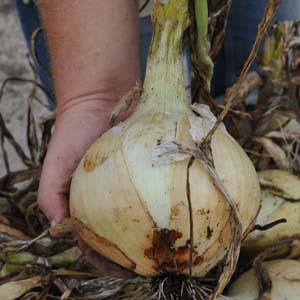
In order to keep the seedlings moist and warm until germination, place a transparent cover (glass, perspex or cling film) over the seed tray. Remove this cover as soon as the first seedling germinates, usually after 2 weeks. Move the seedlings to small (9cm) individual pots when they are at their crook stage. These pots can be filled with John Innes potting compost no.1. Prick the seedling out of the seed tray using a pencil/dibber, holding the leaf, and lift out the root ball carefully. Once potted up, only water the seedlings as required. Ensure good ventilation or the seedlings will be prone to fungal diseases.
The seedlings can be hardened off mid-late march by moving them to a cold frame. Your giant onion seedlings can be then planted outside in the trenches during late April. The onion is mature between August and September, when the foliage starts to turn yellow and fall over, and should be harvested a few weeks after. Lift the onions on a dry day and move them to a suitable location to dry for 3-5 weeks. This will allow them to mature prior to using in the kitchen, or impressing your friends!
For related articles click onto:
Growing herbs
Growing rhubarb
Growing potatoes
Growing tomatoes
Growing tomatoes from seed
Harvesting potatoes
How to grow broccoli from seed
How to grow cauliflower from seed
How to grow garlic
How to build a cold frame
How to grow artichokes from seed
How to Grow Asparagus from Seed
How to grow cabbage from seed
How to grow carrots from seed
How to grow cucumbers from seed
How to grow french beans from seed
How to grow lettuce from seed
How to grow onions from onion sets
How to grow onions from seed
How to Grow Pumpkins from Seed
How to grow runner beans from seed
How to grow runner beans from seed
How to grow seeds indoors
How to grow strawberries from seed
How to grow tomatoes from seed
How to make compost
How to propagate using division
How to propagate from seed
Subscribe to:
Posts (Atom)


